Sikorsky S-92
Cougar Helicopters, C-GZCH
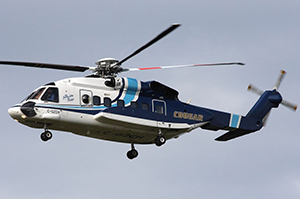
Source: Transportation Safety Board of Canada
St. John's, Newfoundland, Canada
March 12, 2009
On March 12, 2009, a Cougar Helicopters' Sikorsky S-92A helicopter was on a flight to transport workers to a production platform in the Hibernia oil field approximately 120 nautical miles offshore. It experienced a rapid and complete loss of oil from the transmission's main gearbox approximately 47 nautical miles from land. The flight crew declared an emergency and reversed course, attempting to return to its departure airport, St. John’s International. The pilot descended the helicopter to approximately 800 feet above sea level (ASL) and leveled off. Approximately 11 minutes after the rapid loss of oil pressure, about 35 nautical miles from St. John's, and during an attempted ditching, the helicopter struck the water at a high rate of descent. One passenger survived with serious injuries and the other 17 occupants of the helicopter were fatally injured.
The Transportation Safety Board of Canada (TSB) listed the failure of two of the three oil filter mounting studs for the main gearbox (MGB) as one of the main accident findings. This resulted in a rapid loss of oil, causing overheating and the eventual failure of the pinion gear, which is connected to the tail rotor drive.
TSB Report Number: A09A0016
Accident Overview
History of the Flight
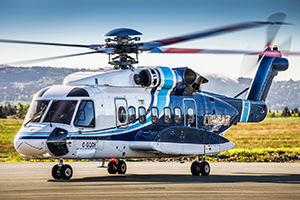
Source: Jan Jasinski
On March 12, 2009, at 0917 Newfoundland Daylight Time, a Cougar Helicopters’ Sikorsky S-92A (registration C-GZCH, serial number 920048) and operated as Cougar 91 departed St. John’s International Airport (CYYT). The helicopter included 16 passengers and two crew members destined for the Sea Rose oil platform, a part of the Hibernia oil field in the North Atlantic Ocean, about 120 nautical miles (nm) offshore. The flight was planned to be about one and a half hours long at an altitude of approximately 9,000 feet above sea level (ASL).
Approximately 30 minutes into the flight, the flight crew received a main gearbox pressure red warning light (MGB OIL PRES). The warning message was accompanied by the aural warning: "GEARBOX PRESSURE...GEARBOX PRESSURE." The captain directed the first officer to locate and begin the checklist procedure for low MGB oil pressure. Twenty-five seconds later, the main gearbox oil pressure had dropped below five pounds per square inch (psi). The combination of the red MGB OIL PRES warning message and main gearbox oil pressure below five psi constituted a "land immediately" condition in accordance with the S-92A Rotorcraft Flight Manual (RFM). The helicopter was about 54 nm from the St. John's International Airport and approximately 47 nm from Cape Spear, which was the closest land.
According to the accident report, the captain advised Gander Area Control Center (ACC) that they had lost all main gearbox oil pressure. Gander notified the Joint Rescue Coordination Center (JRCC) in Halifax of their situation. Instead of immediately following the emergency procedures related to a loss of main gearbox oil pressure, the flight crew attempted to diagnose the problem. The captain advised the Cougar dispatch center to get another helicopter ready in case a ditching rescue was required. The captain indicated to the Cougar dispatch center that he suspected the main gearbox had experienced a pump failure or an oil pressure sensor problem. He stated the oil pressure was at zero and the oil temperature had not increased as he expected but was still indicating normal operating temperatures. He also stated that they were headed directly for the closest land. A senior company pilot in the dispatch center suggested that they review the emergency descent and ditching checklist to ensure that they would be ready for that eventuality. The captain initiated a descent to be closer to the water in case they had to ditch.
When the first officer finished reading the emergency procedure, he stated that they were in a "land immediately" situation. The captain acknowledged the statement; however, he indicated that his intention was to stop the descent at 1,000 feet rather than ditch. The aircraft eventually descended to 800 feet where the captain increased power to assess the helicopter's response. He stated that regardless of the response, he wanted to get to shore as fast as possible. The captain also stated that unless they detected indications of grinding or pounding, he would continue with the flight and that the only reason that he would carry out a ditching would be if the helicopter started to come apart.
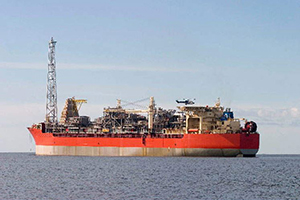
Source: Offshore-Technology.com
The actions that the captain took did not follow the emergency procedure for a loss of main gearbox oil pressure. The emergency procedure stated the airspeed and power level that the aircraft should fly in preparation for an emergency landing. The statement of "land immediately" in the emergency procedure means that the pilot shall not continue to a more suitable location for landing. Doing so likely results in a catastrophic event before the helicopter can make it to the more suitable location.
According to investigators, the captain and first officer did not use effective crew resource management (CRM) during the emergency. The captain wanted to diagnose the situation and continue to fly the aircraft to the nearest land even though the first officer stated more than once that the procedures dictated that they were in a land immediately situation. The first officer was not assertive and did not firmly question the captain’s decision to continue flight, putting all occupants in danger. The captain told the first officer what they were going to do despite knowing he was not following emergency procedure.
The airspeed flown during emergency was above what was proscribed in the RFM, which required more torque to be transmitted through the gearbox, creating additional heat. The altitude flown was also too high for an emergency flare maneuver to be executed properly.
Approximately 11 minutes after the loss of main gearbox oil pressure, the captain made an immediate decision to ditch and advised Cougar dispatch of his decision. As the helicopter descended, it experienced a loss of drive to the tail rotor. This caused the helicopter to begin to rotate. The pilots shut down both engines since the ability to counteract the engine's torque from the main rotor was lost. Immediately following engine shutdown, the collective was raised, causing the main rotor rpm to quickly decrease. The collective was raised at an altitude and airspeed too high to enter a landing flare maneuver to arrest the vertical descent. Therefore, the helicopter descended at a high vertical speed, likely out of control, until collision with the water. The helicopter impacted the water in a slight right-bank, nose-high attitude approximately 35 nm from CYYT. The impact with the water was so hard that it severely damaged the helicopter structure. The damage to the fuselage and systems prevented the helicopter's emergency flotation system from deploying. The helicopter sank quickly in approximately 554 feet of water. Only one passenger survived the accident.
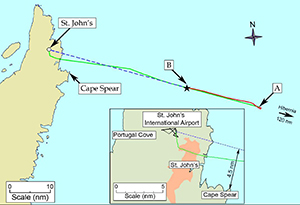
Source: Transportation Safety Board Canada
View Larger
CHI91 Flight Path
The illustration depicts the outbound portion of CHI91's flight path prior to the red MGB OIL PRES warning message (solid green line), the point where the oil pressure loss occurred (point A), the return portion of the flight (red line), and the approximate position of water impact (point B). The blue dashed line is the projected track from the impact position direct to CYYT. The inset shown depicts the distance between Cape Spear and the direct track followed by the helicopter from the diversion point to CYYT.
S-92A Main Gearbox Certification
Sikorsky used Advisory Circular 29-2C, section AC 29.927, which prescribed a test for Category A rotorcraft. It was intended to demonstrate that in the event of a major failure of the lubrication system used on the rotor drive system, no hazardous failure or malfunction occurs in the rotor drive system that impairs the capability of the crew to execute an emergency descent and landing.
The initial certification loss of lubricant test was conducted by draining the main gearbox and using only the remaining residual oil (approximately 1.3 gallons) then continuing operation in accordance with the requirements of AC 29-2C. The main gearbox suffered a catastrophic failure about 11 minutes after the test was started. The gearbox experienced a loss of drive due to the complete loss of teeth from the sun gear. This occurred because of the excessive temperature caused by lack of lubrication.
Following the loss of lubricant test, instead of redesigning the transmission to provide a 30-minute run dry capability, Sikorsky revisited the requirements of Part 29.927(c)(1). With guidance from AC 29-2C, it was concluded that, except for a potential failure of the oil cooler and its exterior plumbing, all other main gearbox failures leading to a total loss of oil were "extremely remote." Based on past service history, a failure in the main gearbox oil filter bowl assembly or its attaching fasteners was not considered when performing the initial design assessment in the context of Part 29.927(c)(1). This was consistent with industry practices.
14 CFR Part 29.927(c)(1) does not define the term "extremely remote;" however, other regulatory documents and industry practices describe these failure conditions as those not anticipated to occur to an aircraft during its total life, but which may occur a few times during the total operational life of all aircraft of that type. Where numerical values are used, this is normally interpreted as a probability in the range of 10-7 to 10-9 hours of flight. In considering what "extremely remote" means in the context of Part 29.927(c)(1), Sikorsky and the FAA looked at what they considered to be reasonable criteria. They looked at factors such as excess strength, low loads, and historical data that included the service history of the S-70/UH-60 Black Hawk.
The most likely cause of a main gearbox oil leak was believed to be through the oil cooling system. As a result, a bypass valve was incorporated for the oil cooler assembly. The loss of lubricant test was repeated with the bypass system installed. A bypass valve had not previously been used as a method of maintaining an oil reserve to meet the loss of lubricant requirements of Part 29.927(c)(1). However, the FAA considered it to be consistent with the typical failure modes of interest identified in AC 29-2C.
This test was conducted by draining oil from a leak in the oil cooler system. The leak was isolated and further oil loss was prevented when the bypass valve was activated. It was required that the pilot activate the bypass valve within five seconds after the MGB OIL PRES warning has illuminated. About 4.3 gallons or 40% of the maximum oil quantity remained in the main gearbox. The test's purpose was to demonstrate that the S-92A main gearbox could provide continued safe operation for a minimum of 30 minutes following perception from the flight crew of lubricating oil loss. The test was repeated five times. At the end of testing the main gearbox displayed no indication of loss of drive or impending seizure. Up until the S-92A certification process, compliance with Part 29.927(c)(1) was demonstrated by performing the loss of lubricant test using only residual oil.
Wreckage Examination
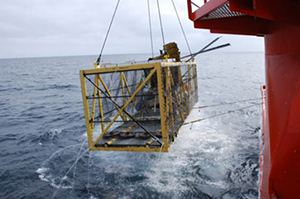
Source: Transportation Safety Board of Canada
The wreckage was recovered and examined by investigators. Two of the three main gearbox oil filter bowl mounting studs were found fractured, causing the filter bowl housing to leak and lose most of the oil from the main gearbox. The two oil filter bowl mounting studs had fractured from fatigue. Fatigue fractures occur when stresses such as tension or bending are cycled and repeated over a length of time. The cyclic fatigue stress on the studs was both bending and tensile, and related to oil pressure within the filter bowl.
The studs were made of titanium alloy and showed evidence of galling on the threads where the steel nuts are tightened. Galling is a form of wear due to excessive friction between two moving surfaces such as a nut on a bolt or stud. Material is removed or displaced from one surface and can transfer to the other surface, changing the characteristics of the assembly. Titanium threads can be more prone to galling after repeated installation of the same nuts.

Source: Transportation Safety Board Canada
View Larger(Photo 1) View Larger(Photo 2)
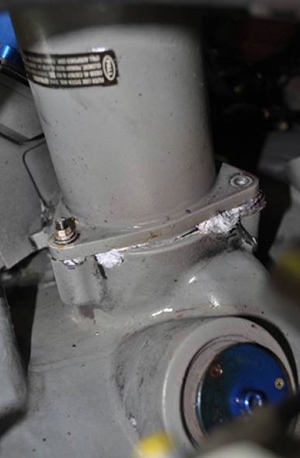
Source: Transportation Safety Board Canada
Examination of the main gearbox components showed damage due to frictional heating caused by the continued operation without oil. This led to the failure of the tail rotor drive take-off pinion gear's teeth, eventually causing the loss of drive to the tail rotor shafts (see photo of damaged pinion compared to an undamaged part). There was no indication that other components had seized that would have prevented the main rotor from turning freely at the time of impact.
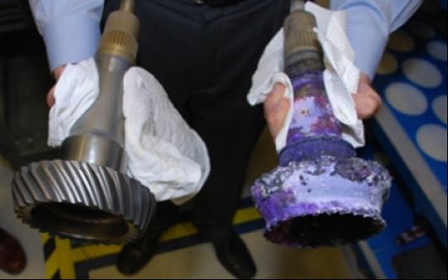
Source: Transportation Safety Board Canada
TSB examined the stud which remained in CHI91's main gearbox housing (see photo). They conducted testing on new stud and nut assemblies to determine the nut and stud damage and the effect on preload associated with repetitive assembly cycles. Examination of a new stud and nut showed that galling damage developed after the first installation and that the damage became progressively more severe with repeated installation/removal cycles (see photo). Testing of the new studs and nuts showed that after 13 to 17 assembly cycles, the nut self-locking feature was significantly damaged in the threads.
The galling on these studs would have been detectable using 10x magnification, and on some studs the damage would have been visible without the aid of magnification. The nuts and studs on CHI91 had accumulated sufficient galling damage to potentially prevent the correct preload from being applied during installation. The main gearbox oil filter bowl attachment nuts had a gray paint residue that had been applied when the main gearbox was manufactured, indicating that the nuts had never been replaced.
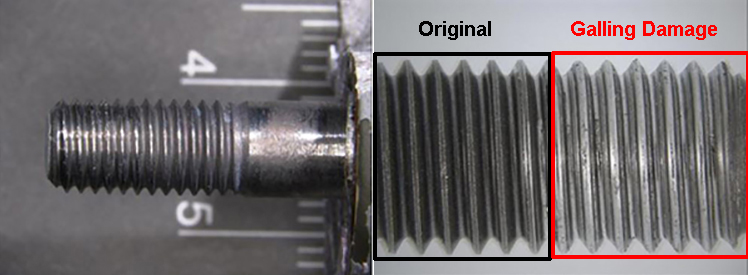
Photo of new stud (right) – Left side shows original threads, right side shows after ten installation/removal cycles using the same nut
Source: Transportation Safety Board Canada
Cougar Helicopters' Main Gearbox Filter Replacement Practices
At the time of the accident, the nuts that were used on the main gearbox filter bowl were required to be recorded in the helicopter's maintenance records, if replaced. Cougar Helicopters determined the end of serviceability of a self-locking nut when the self-locking feature was no longer effective. At the time of the accident, Sikorsky required replacing the nuts every time they were removed.
From the time the occurrence helicopter was manufactured until the accident occurred, the helicopter underwent 11 main gearbox oil filter replacements. During the last two replacements on the occurrence helicopter, aircraft maintenance manual (AMM) Revision 13 was in effect. Cougar Helicopters had inserted AMM Revision 13 into its maintenance computers in November 2008. At the time of the accident, there was no record of the 10x magnification inspection being performed, nor was there a record of a torque wrench being used to measure the proper torques on any of Cougar Helicopters' S-92As, even though required by AMM Revision 13. AMM Revision 13 also required the oil filter mounting nuts to be changed at each removal.
Cougar Helicopters' practice was to change the main gearbox oil filters at 500-hour intervals as well as whenever the impending bypass button popped on the oil filter. On the occurrence helicopter, the main gearbox oil filter had been replaced a total of 11 times. No records indicated that the nuts securing the filter assembly had ever been replaced since the aircraft was manufactured. The nuts showed remnants of the manufacturer’s gray paint that was used on the main gearbox, indicating they were most likely the original nuts.
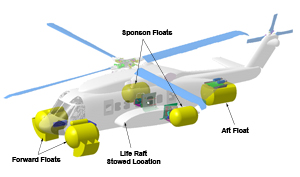
Source: Sikorsky
View Larger
Aircraft Ditching and Floatation
The S-92A helicopter is equipped with an emergency flotation system (EFS) that is designed to keep the helicopter upright and afloat long enough for all crew and passengers to evacuate the aircraft in mid sea state 5 conditions (wave height 8-12 feet with a wind speed of 18-24 knots). The sea state at the time of the accident was estimated to be sea state 5. The waves were estimated to be eight feet and the wind speed was approximately 22 knots. The floatation system can be armed by the pilots when the helicopter airspeed is below 80 knots. When the floatation system has been armed, it can be activated by the pilots after they land the helicopter in the water. The system also incorporates immersion switches in the main gear wheel wells that automatically activate and deploy the floats when the switches are immersed in water. The floats are not designed to absorb the force of a severe impact with the water and are intended to only be deployed after the pilots make a controlled landing in the water. Since the helicopter entered the water at a high rate of descent, the helicopter structure was severely damaged and the emergency flotation system did not deploy.
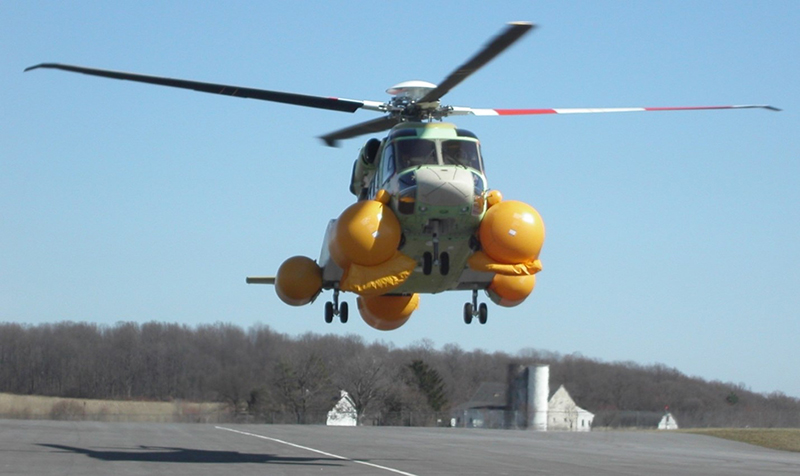
Source: Sikorsky
View Larger
The helicopter is also equipped with two life rafts, one stowed in the forward portion of each sponson. Both life rafts fully inflated and were found floating near the impact site. The rafts likely inflated when the lanyards, attached to the rafts and used to manually inflate them, were pulled as the storage compartment covers separated from the sponsons at the time of the impact.
All individuals on board the aircraft were wearing cold water immersion suits and personal locator beacons. They had also completed personal safety training which included basic survival training and helicopter underwater escape training (HUET).
Investigators determined that the deceleration force from the impact with the water and the fuselage deformation in this occurrence were survivable. The severe structural break-up and subsequent lack of float deployment prevented the helicopter from remaining afloat and, combined with the impact force and cold-water temperatures, impaired the ability of the occupants to escape.
Conclusion
The investigation determined that the studs used to fasten the main gearbox oil filter assembly failed in flight, causing loss of nearly all oil in the gearbox. The captain attempted to fly the aircraft back to shore rather than perform an emergency landing in the water as directed by the emergency checklist. After approximately 11 minutes there was an internal failure to one of the gears in the gearbox, due to lack of lubrication, which caused the aircraft to lose directional control. The crew was forced to make an emergency landing, resulting in a collision with the water. The aircraft was substantially damaged; therefore, the emergency floats were unable to deploy. The helicopter sank almost immediately, not allowing time for the occupants to escape. The frigid water temperature also contributed to the inability for the occupants to survive. Only one of the 18 occupants survived the accident.
The Transportation Safety Board of Canada (TSB) does not list a probable cause to the accident; however, they identified several findings that contributed to this accident.
A complete list of accident board findings can be found at: A09A0016 TSB Accident Board Findings
Main Gearbox
- Galling on a titanium attachment stud holding the filter bowl assembly to the main gearbox prevented the correct preload from being applied during installation caused by the re-use of the original nuts during multiple oil filter changes.
- Reduced fastener preload on the main gearbox oil filter assembly led to an increased cyclic load and fatigue cracking on attachment studs, resulting in failure of the studs and a sudden loss of oil in the main gearbox.
- Loss of lubricant in the main gearbox caused a catastrophic failure of the tail rotor drive pinion gear in the main gearbox, resulting in the loss of drive to the tail rotor shafts and tail rotor.
Emergency Procedures
- The crew should have continued with the descent and ditching as per the emergency procedure. Instead, leveling off at 800 feet above sea level and using a higher power setting and airspeed than required likely accelerated the loss of drive to the tail rotor and significantly reduced the probability of a successful, controlled ditching.
- The throttles were shut off prior to lowering the collective in response to the loss of tail rotor thrust, causing significant main rotor rpm droop. This led to difficulties controlling the helicopter and put the helicopter in a downwind autorotative descent with main rotor rpm and airspeed well below prescribed limits. This led to an excessive rate of descent from which the pilots could not recover prior to impact.
Floatation and Survivability
- The severity of the impact prevented proper inflation of the floatation devices for the aircraft, causing it to sink. The impact and the cold-water temperature also likely contributed to the loss of life of the occupants.
TSB Report Number: A09A0016
A complete list of accident board recommendations can be found here: Accident Board Recommendations
The Canadian Transportation Safety Board made the following recommendations related to the Cougar S-92A accident.
- The Canada Department of Transport require commercial air operators to provide contemporary crew resource management (CRM) training for Canadian Aviation Regulations (CARs) subpart 703 air taxi and CARs subpart 704 commuter pilots. (Transportation Safety Recommendation A09-02)
- The Federal Aviation Administration, Transport Canada, and the European Aviation Safety Agency remove the "extremely remote" provision from the rule, requiring 30 minutes of safe operation following the loss of main gearbox lubricant for all newly constructed Category A transport helicopters and, after a phase-in period, for all existing ones. (Transportation Safety Recommendation A11-01)
- The Federal Aviation Administration assess the adequacy of the 30-minute main gearbox run-dry requirement for Category A transport helicopters. (Transportation Safety Recommendation A11-02)
- Transport Canada prohibit commercial operation of Category A transport helicopters over water when the sea state will not permit safe ditching and successful evacuation. (Transportation Safety Recommendation A11-03)
- Transport Canada require that supplemental underwater breathing apparatus be mandatory for all occupants of helicopters involved in overwater flights who are required to wear a Passenger Transportation Suit System. (Transportation Safety Recommendation A11-04)
The following regulations cover the requirements for the loss of lubrication test and the content of the Rotorcraft Flight Manual, respectively.
14 CFR §28.917 (b) "Rotor Drive System Design Assessment"
A design assessment must be performed to ensure that the rotor drive system functions safely over the full range of conditions for which certification is sought. The design assessment must include a detailed failure analysis to identify all failures that will prevent continued safe flight or safe landing and must identify the means to minimize the likelihood of their occurrence.
14 CFR §29.927 (c)(1) "Lubrication system failure"
For lubrication systems required for proper operation of rotor drive systems, the following apply:
(1) Category A. Unless such failures are extremely remote, it must be shown by test that any failure which results in loss of lubricant in any normal use lubrication system will not prevent continued safe operation, although not necessarily without damage, at a torque and rotational speed prescribed by the applicant for continued flight, for at least 30 minutes after perception by the flight crew of the lubrication system failure or loss of lubricant.
Note: After this accident the FAA, the European Union Aviation Safety Agency (EASA), and Transport Canada Civil Aviation (TCCA) agreed to change the rule by eliminating the extremely remote provision. EASA published the new version of 29.927 (c). in CS29.927 Amendment 55 in 2014. They also revised the regulation with Amendment 7 with more stringent testing requirements in 2019. The FAA is presently implementing this new version of the rule by special condition and plans to propose this rule change in the Federal Register.
14 CFR §29.1585 "Operating procedures"
(a) The parts of the manual containing operating procedures must have information concerning any normal and emergency procedures, and other information necessary for safe operation, including the applicable procedures, such as those involving minimum speeds, to be followed if an engine fails.
(b) For multiengine rotorcraft, information identifying each operating condition in which the fuel system independence prescribed in Sec. 29.953 is necessary for safety must be furnished, together with instructions for placing the fuel system in a configuration used to show compliance with that section.
(c) For helicopters for which a VNE (power-off) is established under Sec. 29.1505(c), information must be furnished to explain the VNE (power-off) and the procedures for reducing airspeed to not more than the VNE (power-off) following failure of all engines.
(d) For each rotorcraft showing compliance with Sec. 29.1353 (c)(6)(ii) or (c)(6)(iii), the operating procedures for disconnecting the battery from its charging source must be furnished.
(e) If the unusable fuel supply in any tank exceeds 5 percent of the tank capacity, or 1 gallon, whichever is greater, information must be furnished which indicates that when the fuel quantity indicator reads "zero" in level flight, any fuel remaining in the fuel tank cannot be used safely in flight.
(f) Information on the total quantity of usable fuel for each fuel tank must be furnished.
Advisory Circular 29.2C (AC 29.927A, Amendment 29-26)
This AC emphasizes the challenges associated with application of 14 CFR §29.927 regarding the “extremely remote” certification path in lieu of the 30-minute loss of lubrication capability.
Ditching Requirements
The aircraft was designed and certified to meet the structural strength requirements for ditching. The following ditching regulations the aircraft was required to meet can be found at: Ditching Regulations
A list of the titles and numbers for the FAA ditching regulations is also listed below.
14 CFR §29.563 Structural Ditching Requirements
(a) Forward speed landing conditions. The rotorcraft must initially contact the most critical wave for reasonably probable water conditions at forward velocities from zero up to 30 knots in likely pitch, roll, and yaw attitudes. The rotorcraft limit vertical descent velocity may not be less than 5 feet per second relative to the mean water surface.
(b)(2) Auxiliary or emergency float conditions - Floats deployed after initial water contact. Each float must be designed for full or partial immersion prescribed in paragraph (b)(1) of this section. In addition, each float must be designed for combined vertical and drag loads using a relative limit speed of 20 knots between the rotorcraft and the water.
(h) Nonjettisonable doors used as ditching emergency exits must have means to enable them to be secured in the open position and remain secure for emergency egress in sea state conditions prescribed for ditching.
(b) Each practicable design measure, compatible with the general characteristics of the rotorcraft, must be taken to minimize the probability that in an emergency landing on water, the behavior of the rotorcraft would cause immediate injury to the occupants or would make it impossible for them to escape.
(d) It must be shown that, under reasonably probable water conditions, the flotation time and trim of the rotorcraft will allow the occupants to leave the rotorcraft and enter the liferafts required by § 29.1415.
14 CFR § 29.805 Flight crew emergency exits
(a) For rotorcraft with passenger emergency exits that are not convenient to the flight crew, there must be flight crew emergency exits, on both sides of the rotorcraft or as a top hatch, in the flight crew area.
(b) Each flight crew emergency exit must be of sufficient size and must be located so as to allow rapid evacuation of the flight crew. This must be shown by test.
(c) Each exit must not be obstructed by water or flotation devices after a ditching. This must be shown by test, demonstration, or analysis.
14 CFR § 29.807 Passenger Emergency Exits
(b) Passenger emergency exits; side-of-fuselage. Emergency exits must be accessible to the passengers...
(d) Ditching emergency exits for passengers. If certification with ditching provisions is requested, ditching emergency exits must be provided in accordance with the following requirements and must be proven by test, demonstration, or analysis unless the emergency exits required by paragraph (b) of this section already meet these requirements.
(2) For rotorcraft that have a passenger seating configuration, excluding pilots seats, of 10 seats or more, one exit above the waterline in a side of the rotorcraft meeting at least the dimensions of a Type III exit, for each unit (or part of a unit) of 35 passenger seats, but no less than two such exits in the passenger cabin, with one on each side of the rotorcraft. However, where it has been shown through analysis, ditching demonstrations, or any other tests found necessary by the Administrator, that the evacuation capability of the rotorcraft during ditching is improved by the use of larger exits, or by other means, the passenger seat to exit ratio may be increased.
(3) Flotation devices, whether stowed or deployed, may not interfere with or obstruct the exits.
14 CFR § 29.1411 Safety Equipment – General
(a) Accessibility. Required safety equipment to be used by the crew in an emergency, such as automatic liferaft releases, must be readily accessible.
(b) Stowage provisions. Stowage provisions for required emergency equipment must be furnished and must -
(1) Be arranged so that the equipment is directly accessible and its location is obvious; and
(2) Protect the safety equipment from inadvertent damage.
(d) Liferafts. Liferafts must be stowed near exits through which the rafts can be launched during an unplanned ditching. Rafts automatically or remotely released outside the rotorcraft must be attached to the rotorcraft by the static line prescribed in § 29.1415.
(e) Long-range signaling device. The stowage provisions for the long-range signaling device required by § 29.1415 must be near an exit available during an unplanned ditching.
(f) Life preservers. Each life preserver must be within easy reach of each occupant while seated.
14 CFR § 29.1415 Ditching equipment.
(b) Each liferaft and each life preserver must be approved. In addition -
(1) Provide not less than two rafts of an approximately equal rated capacity and buoyancy to accommodate the occupants of the rotorcraft; and
(2) Each raft must have a trailing line and must have a static line designed to hold the raft near the rotorcraft but to release it if the rotorcraft becomes totally submerged.
(c) Approved survival equipment must be attached to each liferaft.
(d) There must be an approved survival type emergency locator transmitter for use in one liferaft.
Canadian Aircraft Regulations (CARs) relevant to this operation
The following regulations specifically apply to this type of operation over water.
CAR 723.23 Aircraft Operating Over Water
(a) the helicopter shall be equipped with an approved emergency flotation kit and operated in accordance with the Emergency Flotation Kit Flight Manual Supplement;
(b) when en route over water, the helicopter shall be operated at an altitude that will provide adequate time for full inflation of the flotation devices prior to water contact;
(c) life preservers shall be carried and stowed so that they are within reach of each person carried when seated with his or her seat belt fastened;
(d) the air operator's Company Operations Manual shall include passenger briefing ditching procedures and a requirement for the pilot to file a flight plan or flight itinerary.
(11) Emergency Procedures Training for Pilots
This training is required on an annual basis and shall include instruction in the location and operation of all emergency equipment. Training devices approved to simulate flight operating emergency conditions, static helicopters, ground demonstrations, classroom lectures, films or other devices may be used for training provided the method used ensures that each flight crew member is adequately trained in the operation or use of all emergency equipment. Where practical training is required, it shall be completed on initial training and every three years thereafter.
(c) operation and use of emergency exits, including practical training;
(d) passenger preparation for an emergency landing or ditching, (as applicable) including practical training;
(e) emergency evacuation procedures, including practical training;
(f) donning and inflation of life preservers (when equipped), including practical training;
(g) removal from stowage, deployment, inflation and boarding of liferafts/slide rafts (when equipped), including practical training;
Emergency Procedure Adherence
There may be a perception that helicopters are designed to support a 30-minute loss of lubrication event. This mindset may motivate pilots to make landing decisions that go against the manufacturer’s required emergency procedures. Therefore, a crew may attempt to extend flight to a perceived safer landing location rather than proceed in accordance with emergency procedures that dictate landing in a more extreme environment.
During the accident flight, even though the emergency procedures dictated that they were in a land immediately situation, the captain did not adhere to the emergency procedure read by the first officer. The captain stated that unless he heard grinding or pounding, he planned to continue the flight and therefore incorrectly assumed they could delay the land-immediately emergency requirement. The first officer was much less experienced in this aircraft model and did not firmly question the captain’s decisions.
Cougar Helicopters Maintenance Practices
Even though Cougar Helicopters incorporated the latest revision (Revision 13) into the aircraft maintenance manual (AMM) there was no record of the 10x magnification inspection being performed, nor was there a record of a torque wrench being used to measure the run-off torques on any of Cougar Helicopters' S-92As, even though it was required by AMM Revision 13. The requirement to replace the mounting nuts with new fasteners at each oil filter removal had also not been accomplished.
The Sikorsky Alert Service Bulletin had been complied with prior to the accident. Even though the aircraft maintenance manual revision was in effect during the last two main gearbox oil filter replacements on the accident helicopter, the operator instead relied on a standard industry practice for determining the serviceability of a self-locking nut by replacing nuts only when the self-locking feature is no longer effective.
- Loss of lubrication – In evaluating the rule requirement for the 30-minute loss of lubrication event on the gearbox design, Sikorsky and regulators considered the "extremely remote" provision of the regulation for loss of gearbox oil. Sikorsky showed through analysis that the most probable source for loss of lubrication for the gearbox was the oil cooler and external lines. The loss of oil through the filter bowl was considered extremely remote and therefore not evaluated. Limited consideration of human error occurred until a precursor event in Australia on a similar aircraft identified human error as a major contributor to that incident
- Inspection protocol – Cougar Helicopters had performed a total of 11 main gearbox oil filters replacements due to normal recurrent maintenance and impending bypass indications without replacing the nuts or inspecting the studs with a 10x magnifying glass
- Filter bowl stud replacement compliance – Cougar Helicopters did not accomplish Alert Service Bulletin (ASB 92-63-014) requiring the replacement of the titanium studs with steel studs
- Emergency procedure compliance – The flight crew did not follow key steps in the emergency procedure including setting the proper power level and landing the helicopter immediately in the water. In failing to do so the main gearbox had an internal failure before the aircraft was able to descend to the water
Operators comply with the alert service bulletins and revisions to other service documents issued by the manufacturer.
- Cougar Helicopters did not incorporate the revision to the aircraft maintenance manual and did not comply with the Sikorsky Alert Service Bulletin requiring replacement of the nut and studs. Cougar Helicopters followed standard industry practices for determining the serviceability of a self-locking nut by replacing nuts only when the self-locking feature was no longer effective.
Pilots adhere to the applicable emergency procedures when confronted with an inflight malfunction.
- The flight crew deviated from the emergency procedure and attempted to troubleshoot the gearbox malfunction instead of landing immediately in the water.
Extremely Remote provision of 14 CFR Part 29.927(c) assumes that a failure is unlikely to occur during the life of the fleet.
- According to Advisory Circular 29-2C, extremely remote events are not expected to occur during the total operational life of a random single rotorcraft of a particular type. These events may occur a few times during the total operational life of all rotorcraft of a particular type based on a probability of between 10-7 to 10-9.
- Sikorsky met the requirement of this rule by using Advisory Circular 29-2C, Section 29.927(c) which states that any failures that result in loss of lubrication are extremely remote and will not prevent continued safe flight for at least 30 minutes. While this compliance approach is allowed, it may not be achievable due, in part, to the unforeseen variables and complexity associated with predicting potential lubrication failure modes and their associated criticality and frequency of occurrence. This includes considering lubrication failures that may result from improper transmission maintenance and servicing.
Sikorsky S-92A, Broome, Western Australia, July 2, 2008
In July 2008, a Sikorsky S-92A helicopter operated by Canadian Helicopters Corporation (CHC), while returning from an offshore oil rig in Australia, experienced a sudden significant reduction in main gearbox oil pressure which was accompanied by a cockpit annunciation of "GEARBOX PRESSURE." The pilots reviewed the emergency procedures and performed an emergency landing in a clearing in the forest. Subsequent investigation identified that two of the three oil filter bowl studs had fractured, causing a rapid loss of oil.
Investigation revealed that during an oil filter replacement approximately one month prior, one of the studs had fractured in the threaded section above the filter bowl flange while the nut was being removed. A new stud and the proper tools were not immediately available, so the operator made a temporary repair installing a self-locking nut on the fractured stud. The self-locking feature of this nut did not fully engage the shortened length of the fractured stud, so a hole was drilled in the nut to lock wire it for security. During the incident flight, after the temporary repair had been made, the stud further fractured causing loss of gearbox oil.
The helicopter's main gearbox oil filter bowl had been removed and reinstalled 17 times during the helicopter's total time in service of 1,233.4 hours.
The two oil filter housing attachment studs failed in fatigue due to progressive cracking. The most probable cause for the stud to fracture was either inadequate preload when the nuts were installed or a loss of preload after the nuts were installed. It was suspected that galling on the titanium studs caused the cracking.
Further Analysis and Risk Assessment by Sikorsky
In August 2008, prior to the Cougar accident, Sikorsky held a webcast with S-92A operators, including Cougar Helicopters. They addressed the CHC incident, stating that while the exact failure mode was still under investigation, Sikorsky personnel suggested that extra attention be given to the condition and torque of filter bowl fasteners. They also discussed the field repair as the possible cause of the stud failure.
Sikorsky performed a risk assessment and determined that the titanium studs in the S-92A main gearbox oil filter bowl should be replaced by steel studs. They however determined that the immediate risk of a reoccurrence could be mitigated by modifying existing maintenance procedures.
In October 2008, Sikorsky issued Safety Advisory (SA) SSA-S92-08-007 to advise operators of upcoming changes to the aircraft maintenance manual which included an interim enhanced inspection procedure for the removal and installation of the main gearbox filter bowl assembly. These procedures included an enhanced visual examination of the studs using a 10x magnifying glass and inspection mirror; inspecting gearbox mounting studs for damage, galled threads, broken threads, missing threads, or flattened threads; checking run-off and run-on torques; and mandatory replacement of used nuts with new nuts. Operators were to contact a Sikorsky field representative if any damage was found. On November 5, 2008, with AMM Revision 13, these enhanced inspection procedures became mandatory industry wide.
In January 2009, Sikorsky issued Alert Service Bulletin (ASB) 92-63-014 requiring the replacement of the main gearbox filter bowl titanium mounting studs with steel studs within 1250 flight hours or one year. The compliance time was based on Sikorsky's assessment of the risk and the time it would take to replace the studs in the field without compromising safety. Because the enhanced inspections had been mandatory since the release of AMM Revision 13, both Sikorsky and the FAA felt the immediate risk of reoccurrence had been adequately mitigated and would allow continued safe operation during the specified compliance period.
Advisory Circular 29-2C Certification of Transport Category Rotorcraft
This AC emphasizes the challenges associated with application of 14 CFR §29.927 regarding the “extremely remote” certification path in lieu of the 30-minute loss of lubrication capability. Change 4 explains the difficulty of establishing the extremely remote provision of the rule and the provision may not be achievable because of the consideration of human error and other factors.
14 CFR §29.927 (c)(1) "Lubrication system failure"
After this accident the FAA, EASA, and TCCA agreed to change the rule by eliminating the extremely remote provision. EASA published the new version of 29.927 (c) in CS29.927 Amendment 5 in 2014. They also revised the regulation with Amendment 7 with more stringent testing requirements in 2019.
FAA Special Airworthiness Information Bulletin SW-09-19
On March 19, 2009, the FAA issued Special Airworthiness Information Bulletin SW-09-19 reminding operators to follow the approved S-92A RFM and not the procedures in Sikorsky Safety Advisory SSA-S92-08-006 issued on September 26, 2008 that suggested forthcoming FAA RFM changes pertaining to main gearbox emergency procedures.
Transportation Safety Board of Canada Actions
Aviation Safety Advisory A09A0016-D2-A1
On October 30, 2009, the TSB issued Aviation Safety Advisory A09A0016-D2-A1 (Low Usage of Head Protection by Helicopter Pilots) to Transport Canada and to the Helicopter Association of Canada. The safety advisory indicated that these organizations may wish to consider creating an advocacy program designed to substantially increase head protection use amongst helicopter pilots.
Following the issue of A09A0016-D2-A1, Transport Canada reprinted the advisory in its entirety in its Aviation Safety Letter (ASL 2/2010). In the associated article, titled “Helicopter Safety Helmets – A Hard Shell” they expanded on the issue, stating: "This is one proven but overlooked safety innovation that greatly increases accident survivability and resulting quality of life, and it is fully supported by Transport Canada."
Aviation Safety Advisory A09A0016-D3-A1 (A2-A3)
On December 7, 2009, the TSB issued Aviation Safety Advisory A09A0016-D3-A1 Sizing of Passenger Transportation Suit System (PTSS) to Transport Canada, A09A0016-D3-A2 to the FAA, and A09A0016-D3-A3 to EASA. The safety advisory indicated that the addressees may wish to inform offshore operators about the importance of confirming appropriate PTSS sizes.
Transport Canada ensured that Canadian operators who were conducting overwater flights and using helicopter transportation suits, or survival suits, received a copy of the TSB Aviation Safety Advisory. Transport Canada also informed national aviation associations such as the Helicopter Association of Canada, the Northern Air Transport Association, the Air Transport Association of Canada, and the TSB Aviation Safety Advisory.
A response dated March 23, 2010 was received from the Head of Products Department in the Certification Directorate of EASA stating that "European immersion suit manufacturers consider the fit of an immersion suit to be critical, both in terms of garment and seals, in exceeding airworthiness compliance with the ETSO (previous UK CAA Specification No. 19)." It advised that "European ETSOA holders for immersion suits had been made aware of Safety Advisory A09A0016-D3-A3 to carefully consider the issue of suit sizing in their present and future design as well for the operation of their suits."
Aviation Safety Advisory A09A0016-D1-A1
On January 4, 2010, the TSB issued Aviation Safety Advisory A09A0016-D1-A1 (Sikorsky S-92A Main Gear Box Oil Bypass Switch – Manual Activation) to Sikorsky Aircraft Corporation. The safety advisory indicated that Sikorsky Aircraft Corporation, in coordination with the FAA, may wish to consider the incorporation of a system to automatically activate the main gearbox oil bypass switch as part of the Sikorsky S-92A helicopter design.
Aviation Safety Advisory A09A0016-D4-A1
On March 31, 2010, the TSB issued Aviation Safety Advisory A09A0016-D4-A1 (Adequacy of Emergency Flotation System Requirements for Helicopters) to Transport Canada. The safety advisory indicated that Transport Canada may wish to consult with helicopter operators to ensure that their helicopters are equipped with emergency flotation equipment appropriate for the prevailing sea state conditions over which they operate.
After receiving the TSB Aviation Safety Advisory, Transport Canada Aircraft Certification researched and reviewed the information in the letter and decided to instruct all Helicopter Regional Superintendents to forward a copy of the safety advisory to all helicopter operators who might be involved in offshore operations. The purpose of Transport Canada’s letter was to remind carriers operating in the offshore environment that they should assess their particular areas of operation and ensure that their helicopters are equipped with emergency flotation equipment appropriate for the prevailing sea state conditions.
Sikorsky S-92A Rotorcraft Flight Manual Revisions
On May 13, 2009, the FAA approved the RFM revisions for normal and emergency crew procedures for main gearbox malfunctions. On June 16, 2009, the FAA issued AD 2009-13-01 implementing the RFM revisions effective July 1, 2009.
The preamble of the AD was as follows:
"This amendment is prompted by an accident, by recent RFM changes made by the manufacturer that were not available when we issued the existing AD, and by our determination that certain MGB Normal and Emergency procedures in the RFM are unclear, may cause confusion, and may mislead the crew regarding MGB malfunctions, in particular the urgency to land immediately after warning indications of loss of MGB oil pressure and oil pressure below five pounds per square inch (psi)."
The revised RFM included guidance to pilots that a total loss of main gearbox oil pressure may result in main gearbox failure in less than ten minutes.
European Aviation Safety Agency issued Safety Information Bulletin (SIB) 2009-05
This SIB advised S-92A operators it supported CCS-92A-AOL-09-0008 but not SSA-S-92A-08-006 which referred to RFM amendments not yet approved by the FAA. Since EASA believed that operators could interpret the SSA as being mandatory and not just advance notice of proposed changes, EASA instructed its operators to continue following the procedures in the approved RFM.
Sikorsky Design Changes
The S-92A oil cooler bypass valve system was redesigned. The new design automatically bypasses the oil cooler when a sudden loss of oil pressure occurs that may be due to a leak of the oil lines or cooler assembly. The design includes the ability to revert to manual mode, if needed.
Sikorsky redesigned the main gearbox oil filter housing assembly. The original design on the accident aircraft had an oil filter assembly that was attached with three mounting studs and nuts. The assembly was redesigned to incorporate six bolts and nuts for attachment of the filter bowl housing assembly. It also incorporated stiffening ribs to reduce bending stress on the fasteners.
Sikorsky incorporated a main gearbox failed pump indicator into the system. The flight crew receives a notification on the cockpit displays if there is a failed main gearbox pump. It also indicates which pump has failed.
The main gearbox lubrication system has also been improved to include an upgraded pump retainer and an anti-clog inlet.
Sikorsky established inspection details on housings and the pump mount area to discover any developing leak paths.
Sikorsky also developed an oil lubrication system hazard analysis to complement the design assessment. This method considers failure potential modes of all parts and features of the system, from a loss of lubrication perspective. The document uses service history and test data to quantify risks.
2009-07-53 This emergency AD requires the installation of steel filter bowl attachment studs. This action is necessary to prevent fretting and galling of the threads in the studs to ensure proper preload levels are achieved during filter replacement and to reduce the potential for an oil leak.
2009-13-01 Remove all main gearbox filter bowl mounting titanium studs and replace them with steel studs. This AD supersedes the previous AD to require replacement of the filter bowl studs and insertion of revised procedures into the Normal Procedures and Emergency Procedures sections of the RFM. These actions are necessary to reduce the potential for main gearbox oil leakage and to provide clear RFM procedures to deal with main gearbox anomalies.
2009-25-10 One-time visual inspection of the main gearbox lube system filter assembly for oil filter damage. This AD requires a one-time inspection of the main gearbox oil filter assembly to identify inadvertent use of oversized O-ring packings during filter installation that could cause overloading of the attachment studs and possible fatigue cracking. This action is intended to prevent failure of the filter bowl attachment studs which could result in main gearbox oil leakage.
2010-10-03 Replace the main gearbox filter bowl assembly with a two-piece main gearbox filter bowl assembly and replace the existing mounting studs. This AD requires the installation of a significantly modified main gearbox oil filter bowl assembly featuring additional strengthened fastener components. This action is necessary to prevent failure of the filter bowl attachment studs which could result in main gearbox oil leakage.
2012-14-08 This AD requires inspection for cracks in specific external surface locations of the main gearbox. This is required to identify cracks in the cored passages of the main gearbox that transport pressurized oil to internal components, which can result in main gearbox oil leakage.
2015-11-10 This AD requires the installation of a system that detects a main gearbox oil pump failure, a system that provides automatic oil cooler bypass valve activation in the event of a low oil pressure condition, and an aural annunciation when oil pressure falls below a prescribed level. These modifications are required to enable the flight crew to distinguish between a failed oil pump and an oil leak as the cause of low main gearbox oil pressure; to provide rapid automatic activation of the oil cooler bypass valve when oil pressure decreases; and to provide an audible cockpit message when oil pressure decreases.
2020-16-19 This AD requires a modification of the aircraft electrical system to minimize the effect of a tripped circuit breaker for the main gearbox oil temperature warning system. This is required to prevent a tripped circuit breaker from causing numerous erroneous and conflicting main gearbox oil system cockpit indications that could lead to an unnecessary forced landing.
EASA AD 2009-0217-E Main Rotor Drive - Main Gearbox Lubrication System Filter Components - One-Time Inspection
EASA AD 2010-0015 Main Rotor Drive - Main Gearbox Filter Bowl Assembly - Replacement
Rotorcraft Life Cycle:
- Operational
Accident Threat Categories:
- Loss of Control- Inflight (LOC-I)
- System/Component Failure or Malfunction (non-powerplant) (SCF-NP)
Industries:
- Offshore
Accident Common Themes:
- Organizational Lapses
- Human Error
- Pre-existing Failures
- Unintended Effects
- Flawed Assumption
Organizational Lapses
Sikorsky published and distributed a Safety Advisory recommending enhanced inspections and an Alert Service Bulletin and changes to the aircraft maintenance manual requiring replacement of the titanium studs with steel studs after a similar event in Australia. Cougar Helicopters did not comply with these documents and did not perform the enhanced inspections or replace the studs prior to the accident.
Flawed Assumptions
During the certification of the S-92 main gearbox, it was assumed that the most likely cause of an oil leak was from the oil cooler and external lines. The oil filter housing and human error related to improper maintenance practices was not considered a likely cause of an oil leak.
Pilots should not assume there would be sufficient time from transmission of power until a catastrophic failure occurs to execute a ditching. In this accident, the captain stated that he would continue to fly until he heard grinding or pounding or a determination that the helicopter was coming apart.
Human Error
The combination of the red MGB OIL PRES warning message (primary indication) and main gearbox oil pressure below five psi (secondary indication) constituted a "land immediately" condition as per the S-92A RFM. The flight crew was aware this was specified in the RFM but decided to continue to fly the aircraft to attempt reaching shore.
Unintended Effects
The temperature indication for the main gearbox did not rise when the crew received a warning that main gearbox oil pressure was lost. The temperature sensor was indicating the ambient air in the gearbox since there was not any oil for the temperature sensor to read. Even though the training the pilots received stated this may occur, the crew thought that since the oil temperature did not rise, there was still oil in the gearbox and there may have been a sensor failure.
Pre-Existing Conditions
The studs used to secure the oil filter housing to the main gearbox had pre-existing cracks from the galling caused by reusing the nuts. Sikorsky S-92A maintenance procedures stated that nuts should be discarded and replaced every time the oil filter housing is removed to prevent damage to the studs. Sikorsky also published a Sikorsky Safety Advisory SSA-S92-08-007 in October 2008 to visually inspect the threads of the studs for pre-existing cracks and other damage.
Airbus Helicopters AS 332 L2, Peterhead, Scotland, April 1, 2009
n Airbus Helicopters AS 332 L2 Super Puma (G-REDL) crashed 11 nautical miles northeast of Peterhead, Scotland while on a passenger flight. There was a catastrophic failure of the main gearbox that initiated in one of the second stage planetary gears. The gear cracked because of a fatigue crack.
Airbus Helicopters, EC225 LP, Aberdeen, Scotland, North Sea, May 10, 2012
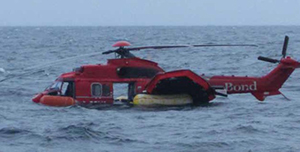
Source: NTSB
An Airbus Helicopters EC225 LP Super Puma (G-REDW) made a controlled descent and successfully ditched in the North Sea 34 nm east of Aberdeen, Scotland while transporting oil workers from Aberdeen to an oil platform.
The helicopter suffered a loss of gearbox oil pressure and a rise in gearbox temperature. The pilot followed emergency procedures, activated the emergency lubrication system, and landed in the water. The pilot activated the emergency floats and the helicopter remained afloat and upright. All the occupants exited the aircraft and entered a liferaft. All 14 occupants survived the event. The loss of oil pressure was caused by the failure of a bevel gear shaft due to a fatigue crack.
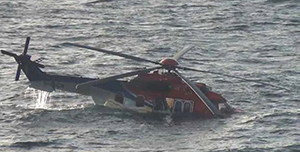
Source: NTSB
Airbus Helicopters EC225 LP, Sumburgh, Scotland, North Sea, October 22, 2012
An Airbus Helicopters EC225 LP Super Puma (G-CHCN) had ditched in the North Sea approximately 32 nm southwest of Sumburgh, Shetland Islands. The helicopter suffered a loss of gearbox oil pressure and a rise in gearbox temperature. The pilot followed emergency procedures, activated the emergency lubrication system, and landed in the water. The pilot activated the emergency floats and the helicopter remained afloat and upright. All the occupants exited the aircraft and entered a liferaft. There were no fatalities because of the event. The loss of oil pressure was caused by the failure of a bevel gear shaft due to a fatigue crack.
Airbus Helicopters EC225LP, Turoy, Norway, April 29, 2016
An Airbus Helicopters EC225LP (LN-OJF) crashed on a small island in the North Sea after the main rotor suddenly detached from the helicopter while transporting oil workers. All 13 occupants were fatally injured. The accident was a result of a fatigue fracture in the second stage planetary gear in the main transmission. The fatigue fracture initiated from a surface micro-pit in the outer race of a bearing.
Airbus AS350-B2, Las Vegas, Nevada, December 7, 2011
An Airbus Helicopters (Eurocopter) AS350 B2 helicopter crashed about 14 miles east of Las Vegas, Nevada because of an in-flight separation of flight control components. The NTSB determined the probable cause of this accident was improper maintenance. This included the improper reuse of a degraded self-locking nut, the improper or lack of installation of a split pin, and inadequate post-maintenance inspections.
Technical Related Lessons
In the event of a transmission lubrication failure, pressure-lubricated gearboxes within the rotor drive system need to be designed to ensure there is capability to transmit power, providing a minimum of 30 minutes of continued safe flight in all conditions. (Threat Category: System/Component Failure or Malfunction – Non-Powerplant (SCF-NP))
- During initial certification testing, the gearbox experienced a failure at 11 minutes. Therefore, the manufacturer used a probability analysis approach that allowed use of the extremely remote provision of the lubrication system failure regulation that called for 30 minutes of continued safe flight.
- While 30 minutes of continued safe flight was not provided, the crew should have safely ditched the aircraft, as dictated by the emergency procedures, prior to a catastrophic failure of the main gearbox, as time from loss of lubrication to gearbox failure in this accident was approximately 11 minutes.
Common Theme Related Lessons
The application of the "extremely remote" provision in 14 CFR Part 29.927 needs to account for all the potential sources of oil leakage and the likelihood of human error in maintenance when designing and certifying lubrication systems for rotor drive systems. (Threat Category: Flawed Assumption)
- Based on history of other aircraft designs, the manufacturer believed that the most likely source of oil leakage was the oil cooler assembly and not the oil filter bowl.
- The conventional use of the "extremely remote" phrase in the certification process requires a quantitative reliability analysis that includes historical data justify the reliability has been met. In a component that is subject to periodic maintenance, such as an oil filter bowl, the effects of human error are broad and difficult to quantify to justify the "extremely remote" design criteria has been satisfied. Human error may be likely and must be considered as a factor in maintenance practices and a potential cause of an oil leak.
- Advisory Circular 29-2C, Section 29.927(c) states that the phrase "unless such failures are extremely remote" in 14 CFR Part 29.927 has caused confusion. The extremely remote language means that testing to demonstrate at least 30 minutes continued flight capability, following loss of lubrication in the normal lubrication system, is not required if the failures leading to that loss of lubrication condition are determined to be extremely remote. While this compliance approach is allowed, it may not be achievable due, in part, to the unforeseen variables and complexity associated with predicting potential lubrication failure modes and their associated criticality and frequency of occurrence. This includes considering lubrication failures that may result from improper transmission maintenance and servicing. The expected compliance approach has been to assume a failure in the normal lubrication system leading to rapid loss of lubrication and to rely on an auxiliary lubrication system or the robustness of the transmission components to accomplish at least 30 minutes of operation at the prescribed conditions.
It is critical to follow the emergency procedures when they dictate to land immediately, even when it means ditching in the water. Failure to follow emergency procedures may result in a catastrophic event. (Threat Category: Human Error)
- To prevent pending loss of control, the aircraft was in a land immediately situation as identified by the emergency procedure; however, the captain decided to continue to the nearest land.
- There was a widespread belief in the industry that there would be secondary indications, such as grinding noises, smoke, fumes, and vibration. Potentially due to the absence of these secondary indications of an impending catastrophic failure, the pilot, by not ditching, ignored the emergency procedures.
- Since the aircraft was equipped with emergency floatation devices and liferafts, and the crew and passengers were wearing immersion suits, it is probable all occupants would have survived had the crew followed emergency procedures and properly ditched the aircraft.
- The crew became fixated on diagnosing the problem and believed that the oil pressure warning may have been a pump failure, a less severe failure, or a faulty sensor.
Manufacturers' alert service bulletins and revised maintenance procedures should be reviewed and decisions on their implementation made in a timely manner relative to the risk presented. (Threat Category: Organizational Lapse)
- After a similar event in 2008, the manufacturer determined that the use of dissimilar materials in threaded fasteners subject to repetitive removal and installation can cause galling. Therefore, the manufacturer sent out revised maintenance procedures and an alert service bulletin requiring inspection of the studs and replacement of the nuts during reassembly.
- Strict compliance with prescribed assembly procedures, fastener re-use instructions, and inspections is necessary to achieve the required level of integrity.
- Investigators determined the manufacturer's maintenance instructions for replacing fasteners were not followed. This caused wear and damage to occur to the fasteners which led to an in-flight failure. The operator had not incorporated the revised maintenance procedures into their operations, nor had they accomplished any of the other manufacturer-recommended actions prior to the accident.
- The protective surface treatment of the mating surfaces on threaded fasteners in the accident aircraft degraded and deteriorated from repetitive removal and reassembly, causing wear and corrosion. This resulted in improper assembly torque and preload in the fasteners and led to a fatigue loading condition that caused failure of the fastener.
